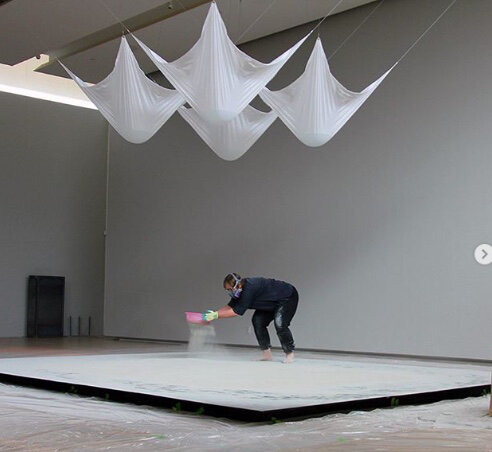LINDA SWANSON
MONTREAL, QUEBEC, cANADA
Linda Swanson sifts raw bentonite onto a metal platform, during the installation of Templum of a Precious Thing of No Value, A Shapeless Thing of Many Shapes, at the Gardiner Museum, Toronto, February 2020. The museum closed due to the Coronavirus shortly after her show opened in early March.
Linda Swanson, Templum of a Precious Thing of No Value, A Shapeless Thing of Many Shapes, 2020. Detail of hanging membranes containing water that drips onto a floor-mounted metal platform covered in powdered bentonite—causing it to crack, congeal and change its color and texture. Photo: Toni Hafkenscheid.
Linda Swanson, Templum of a Precious Thing of No Value, A Shapeless Thing of Many Shapes, 2020. Detail of evolving bentonite surface, under continuous ‘irrigation’ from above; each bentonite circle 20" x 20" x 2". “The bentonite clay I am using has been ground down to a particle form, reduced to a sheer elemental state that is more purely and essentially ‘raw.’ In this condition, it evokes the alchemical and philosophical notion of prima materia – the materialized principle of potentiality underlying the variability and changeability of all substance and form.” Photo: Toni Hafkenscheid.
These are indeed disturbing times—unknown, unseen, unpredictable.
I’ve found it difficult to make during the last ten weeks of quarantine. Part of that was the immediate need to shift to teaching from home. I’m a professor at Concordia University in Montréal, and all of us—students, staff, teachers—were busy reinventing and responding, then planning for a future of uncertainty.
I trace my awareness of the pandemic to the day in February that I arrived in Toronto to install at the Gardiner Museum. The piece, called a Templum of a Precious Thing of No Value, A Shapeless Thing of Many Shapes, invokes the figural structure of the templum (the quadripartite vault of the sky in ancient Roman times, whose sacred order was transferred to the earth in the foundation rites of cities). The templum was first a drawing in the dirt: utilized by augurs to interpret omens.
In my piece, water drips down onto a bentonite field from four light- and water-filled membranes, to enact an exchange between the two structures, and between their respective temporal, material, and formal orders and qualities. The raw potentiality of clay is actualized within the templum structure to engage our perception and experience of our own corporeal being and becoming.
I was finishing some details for this installation while listening to the first US press conference about COVID-19. I was a bit skeptical of the news that the problem would be over before it even began, but also not aware enough to be as concerned as we would all soon become. Just as the show opened, the museum closed.
These days, I set about accomplishing things at a small scale in order to be continually involved in a productive process. I roll the smallest possible coils of clay to the point just before they break, and wrap the lines round and round like a recording, to make objects of containment. Enacting these forms refers to the gesture the entire world is trying to make at the moment, collectively.
Linda Swanson, Templum of a Precious Thing of No Value, A Shapeless Thing of Many Shapes, 2020. 20' x 20' x 19', Installation view in the RAW exhibition at Gardiner Museum, Toronto which opened March 5, 2020. Swanson uses bentonite as a ‘prima material’ a form of undifferentiated matter capable of taking on many forms, akin to a human stem cell. Photo: Toni Hafkenscheid. [Adjacent works: Casils, Up To and Including Their Limits (left corner); Magdolene Dykstra Polyanthroponemia (far wall).]
during the lockdown, LINDA SWANSON has been TEACHING cErAMICS ONLINE, making coiled vessels as “objects of containment,” and planning for “a future of uncertainty” as an educator
Linda Swanson, Containment Vessels series, 2020. As-yet-unfired porcelain.





